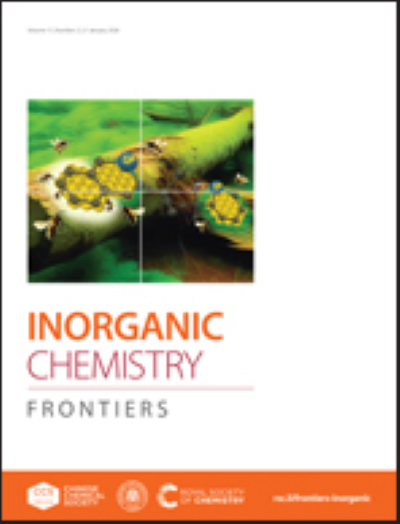基于柔性P,P ' (N,N ')2配体的铸币金属(I)团簇:彩色磷光、异常热猝灭行为及防伪应用
IF 6.4
1区 化学
Q1 CHEMISTRY, INORGANIC & NUCLEAR
引用次数: 0
摘要
利用一种新型的P,P ' (N,N ')2-配体1,2-二[二(吡啶-2-甲基)膦]乙烷(L)组装了具有明显亲金属性Au - X (X = Cu, Ag, Au)或Ag - Ag接触的前所未有的假对称CuI, AgI和AuI簇。它与AuCl/KPF6、AuI或(AuC≡CPh)n相互作用,分别生成[Au2L2]2+、[Au2I2L2]和[Au2(C≡CPh)2L]x (x = 2或n)型配合物。l与AgPF6反应形成一个[Ag4L2]4+簇,而与AgNO3处理形成一个9核[Ag9L3(NO3)3]6+簇。后者经[Au(tht)Cl]处理后转化为异质金属[Au2Ag4L2(NO3)2(H2O)]4+团簇。L与Au(I)卤化物和[Cu(MeCN)4]PF6的顺序反应得到了异质金属[Au2Cu4(μ2-Cl)2L2]4+和[Au2Cu4L2I2(MeCN)4]4+系综。大多数标题团簇在绿色到橙色区域表现出电荷转移光致发光,量子效率高达77%。令人惊讶的是,[Au2Cu4L2I2(MeCN)4]4+团簇显示出异常的(负)热猝灭,这在Au(I)衍生物中是前所未有的。所设计的簇簇的实际效用通过它们作为先进防伪的创新蒸汽响应发射油墨的应用得到了证明。本文章由计算机程序翻译,如有差异,请以英文原文为准。
Coinage metal(I) clusters based on a flexible P,P′(N,N′)2-ligand: colorful phosphorescence, abnormal thermal quenching behavior and anticounterfeiting application
Unprecedented pseudosymmetric CuI, AgI and AuI clusters with pronounced metallophilic Au–X (X = Cu, Ag, Au) or Ag–Ag contacts have been assembled using 1,2-bis[bis(pyridin-2-ylmethyl)phosphino]ethane (L), an innovative P,P′(N,N′)2- ligand. Its interaction with AuCl/KPF6, AuI or (AuC≡CPh)n yields complexes of the type [Au2L2]2+, [Au2I2L2] and [Au2(C≡CPh)2L]x (x = 2 or n), respectively. The reaction of Lwith AgPF6 affords a [Ag4L2]4+ cluster, while the treatment with AgNO3 leads to a nine-nuclear [Ag9L3(NO3)3]6+ cluster. The latter was transformed into a heterometallic [Au2Ag4L2(NO3)2(H2O)]4+ cluster by treatment with [Au(tht)Cl]. Sequential reaction of L with Au(I) halides and [Cu(MeCN)4]PF6 provides heterometallic [Au2Cu4(μ2-Cl)2L2]4+ and [Au2Cu4L2I2(MeCN)4]4+ ensembles. Most of the title clusters exhibit a charge transfer photoluminescence in the green to orange region with the quantum efficiencies up to an impressive 77%. Surprisingly, the [Au2Cu4L2I2(MeCN)4]4+ cluster shows an abnormal (negative) thermal quenching of the luminescence, which is unprecedented for Au(I) derivatives. The practical utility of the designed clusters was demonstrated by their application as innovative vapor-responsive emission inks for advanced anticounterfeiting.
求助全文
通过发布文献求助,成功后即可免费获取论文全文。
去求助
来源期刊

Inorganic Chemistry Frontiers
CHEMISTRY, INORGANIC & NUCLEAR-
CiteScore
10.40
自引率
7.10%
发文量
587
审稿时长
1.2 months
期刊介绍:
The international, high quality journal for interdisciplinary research between inorganic chemistry and related subjects
 求助内容:
求助内容: 应助结果提醒方式:
应助结果提醒方式:


